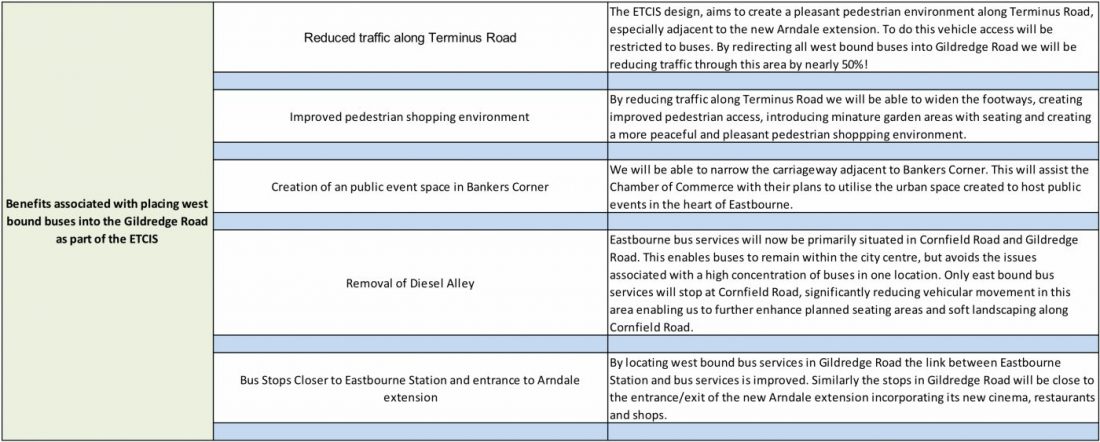Gildredge Road Consultation results
In June 2017 we asked for your opinion on the latest design for the ETCIS. This included the placement of west bound bus stops (those stops currently situated on the southern side of Terminus Road) into Gildredge Road along with a bus lane and new modern bus shelters.
The benefits of these changes include:

Results of Gildredge Road Consultation
The ETCIS project team would like to thank individuals who took the time to complete the questionnaire, distributed in June 2017, regarding the proposals for Gildredge Road. It is very useful for the project team to be given the opportunity to read the notes of support for the proposals put forward as well as the concerns expressed. The table below is a summary of the responses received.

Thirty-seven percent of respondents supported the proposal to place west bound buses into Gildredge Road with a bus lane, listing the ‘dispersal of Diesel Alley’ as a significant benefit and the opportunity to improve the public realm within the town centre.
The project team reviewed the objections against the proposals and it became very clear that the majority of concerns could be split into 3 categories:
The project team have worked very closely with consultants WSP in developing the proposals for Gildredge Road. One of the main concerns of the team was the potential of traffic congestion along Gildredge Road as a result of the proposals. With this in mind a detailed traffic modelling exercise was undertaken utilising VISSIM a behaviour-based multi-purpose traffic simulation program.
Technical Note: VISSIMVISSIM can analyses various typical traffic operations including scenarios of merging / diverging traffic under congested and free flow conditions, with constraints such as lane configuration, traffic composition and priority control. Complex signalised junctions can also be modelled in VISSIM .
A key benefit to VISSIM is that vehicles are modelled in real time and the interaction is captured between junctions which are relatively close together. This captures the interaction between the junctions which is important as it shows possible problems visually. This allows us to make improvements to eliminate these possible problems.
To ensure the accuracy of the traffic modelling, Eastbourne Bus operators were asked to provide information on existing and predicted bus time tables. Traffic counts were undertaken to ensure base line information was correct. Additionally pedestrian surveys were carried out to analyse the impact of the pedestrian operated traffic signals at either end of Gildredge Road. To ensure the robustness of the model a multiplier effect was applied to allow for an increase in traffic over future years and even though peak bus flows and peak traffic flows were noted to be at different times the numbers from both these periods were combined and applied to the model to provide a ‘worse case scenario’.
The results of the traffic modelling showed that at peak periodsa small increase in existing queue lengths may occur, however any queues formed would clear in one phase of the traffic signals at the junction of Terminus Road, therefore ensuring efficient flow of traffic along Gildredge Road.
One of the key objectives of the ETCIS is to increase the attractiveness of Eastbourne Town Centre. This will primarily be achieved by creating a friendly pedestrian environment along Terminus Road. To do this the buses have to be moved out of Terminus Road, but it is important that they are kept as close to the town centre as possible. It is unlikely that moving approximately 50% of the buses currently situated in Terminus Road into Gildredge Road, will have a dramatic effect on pollution levels within Eastbourne Town Centre. However by doing so creates an opportunity to create a modern attractive retail corridor along Terminus Road, capitalising on the £85m investment by Legal & General in the Arndale extension and laying the foundation for further investment in Eastbourne town centre.
It is also worth noting that Since 1993 legislation calling for a decrease in NOx (oxides of Nitrogen) and Particulate Matter (PM) has lead to significant improvement in bus emissions. Since then, bus engine manufacturers have had to invest in new technology to reduce the levels of NOx, PM, and other harmful elements, with the result that there has been a huge reduction in emissions and a great improvement in air quality. In 2014 new legislation meant that any new buses registered had to be fitted with the new Euro 6 approved engine, which produces 75% lower levels of NOx, with the PM reduction approx. 95% lower than the Euro 5 model. The majority of Brighton and Hove bus services and stagecoach services in Eastbourne are fitted with the Euro 6 engines. Such is the advancement in engine manufacture, buses fitted with Euro 6 engines produce far less NOx emissions than most modern diesel cars. Additional developments include stop/start engine tech that triggers when the bus doors are opened and the systems which use power generated during braking to generate electricity to run systems on the bus, thereby reducing load on the engine and enabling buses to utilise smaller more efficient engines.
From the outset of this scheme the project team have been keen to limit the loss of on street parking available within the scheme extent. The table below shows how this has been achieved.

By implementing the proposed design for Gildredge Rd, 2 disabled bays in Gildredge Road will be lost, however overall there will be a gain of 2 disabled bays within the scheme as a whole.
Following careful consideration of the responses supporting the proposed design for Gildredge Road and the concerns raised by those not supporting the scheme, with suitable reflection on the information summarised above the ETCIS Project Board have decided to incorporate the provision of bus stops and associated bus lane into the final design of the ETCIS, subject to the Traffic Regulation Order procedure within which people will be given the opportunity to comment further.
